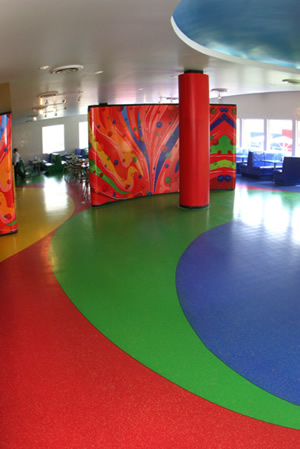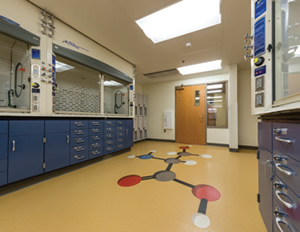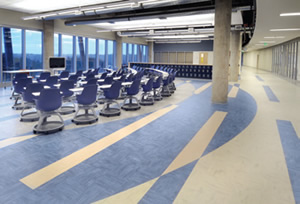Focus On the Floor

PHOTO COURTESY OF STONHARD
Flooring takes up not only a majority of a room’s space, but also serves as a primary target for the eye. If your floors are unique, eye-catching and vibrant, you’re going to see the room come to life.”
That’s how Ellie Dowden of Shannon Specialty Floors describes the role of flooring in a design scheme. It’s a convincing statement, because whatever the manufacturer, product or material, it is clear that there is a wide variety of colors, textures and finishes that lend themselves to diverse design approaches.
It’s also clear that flooring comprises a dynamic scene and there are many factors to consider when envisioning the right floor in a campus building today. College Planning& Management recently sought insights from some industry professionals.
“Education settings have moved away from monochromatic flooring designs and embraced bright and colorful spaces,” Dowden continues. She’s also seeing gathering interest in “textures and high design” and “a lot of traction” with flooring products that enable designers and end-customers “to mix and match colors and patterns for very unique designs and spaces.”
Decision makers must weigh costs, precedent, institutional culture and the nature of the space being renovated or newly constructed, and it isn’t a walk in the park: as Altro Strategic Marketing Analyst Nick Alexandropoulos says about two crucial factors, “sometimes a combination of durability and style is difficult to find.”

PHOTO COURTESY OF NORA SYSTEMS, INC.
For a project at Cañada College in Redwood City, CA, a community college that serves 5,500 day and evening students, the college originally specified linoleum as a standard for the district, but wanted a product that would be easier to install and maintain. After a two-year trial elsewhere on campus, new flooring was installed in the community college’s student center. It is a sustainable vinyl tile with a polyurethane (PU) coating — PU combines “easy maintenance and cleaning” with “durability and resilience” — with soft, creamy colors and a subtle finish. The appearance, performance, and maintenance of the tile have proved superior to linoleum.
Elsewhere, flooring installed at the New England Institute of Technology in Rhode Island features varied patterns, a reflective finish and a coordinated color palette, all keyed to their surroundings. For example, a hallway circle appears in a turn in a hallway, echoing a curved wall, and is juxtaposed with rectangular forms at right angles denoting movement through the space. It’s a simple arrangement that takes an extra step to add color, logic and visual interest.
A SENSE OF IDENTITY
In a broader sense, flooring can exude, reflect and help foster the culture of an institution or department. In other words, colors, patterns and finishes of what’s underfoot can suggest prestige or be formal, informal or playful, or connote sophistication, cosmopolitan style or just the right mood. For example, Shannon Specialty Floors was, at this writing, implementing a flooring project at the University of North Alabama (UNA) where such factors, all under the umbrella of aesthetics, so to speak, were at play. In fact, the UNA project “was derived from the necessity of aesthetics,” Dowden points out. Jeff Collum, Shannon Specialty’s president, puts it this way: “UNA wanted a non-institutional look and one that would make the classroom more ‘warm’ and ‘friendly.’” The resulting design solution: a versatile luxury vinyl tile product that “encompasses woods, marbles, slates and travertine.”
“We have seen logos, patterns and even mascots designed into our floors,” says Dowden, who explains it is extremely important to offer “a wide variety of colors and textures that can be mixed and matched.” To mix and match those precisely, her company uses sonic cutting, a technique that “can help create unique and intricate floor designs for any space,” Dowden explains.
Forbo Flooring Systems of Hazelton, PA, also confirms that today’s flooring materials allow for the installation of surfaces that not only contribute to safety by reducing the potential for slips, trips and falls, but can also be customized with colors, signs, shapes and logos to help with wayfinding within buildings, and contribute to and reinforce institutional branding.
In another sense, the designs of floors strive to envision and relate to the tastes and expectations of their users while at the same time reflecting the culture of an institution.
GREEN MATTERS
Take environmental aspects. Flooring manufacturers are meeting this important expectation in various ways, including using sustainable, recycled and recyclable materials, and content with low-VOC. And environmentally friendly does not take anything away from aesthetics. One example, among various others, is concrete flooring. When compared with high-end floor coverings, such as ceramic tile, slate or marble, decorative concrete is often an economical alternative. Plus, skilled concrete artisans can duplicate the look of these pricier materials. The life expectancy of a concrete floor will also far surpass that of low- to mid-priced floor coverings, such as carpeting, vinyl tile and wood laminates. According to PROSOCO Consolideck Product Manager Kevin Sigourney, there is gathering interest and use in exposed concrete flooring. He explains that concrete flooring products are attractive because of third-party certifications “for transparency of materials and Red List compliant attributes.” That being said, the material offers many decorative, color and finishing options.
AESTHETIC APPEAL
Lauri Watnee of Mohawk Group makes a different point about how flooring products can meet the expectations of their users. “Today’s techsavvy, social and community-oriented college students are strongly attuned to their surroundings and are looking for the experiential, collaborative spaces that support social engagement,” she explains, while higher education facilities’ tendency to go with a “sophisticated design aesthetic” and “to follow corporate design trends.” She continues, “We see the use of subtle beige and grey foundational finishes with energizing bold accents,” with one approach being to “create interest (by mixing) patterns, pattern scale, and color palettes to create a defined yet cohesive look.”

PHOTO COURTESY OF FORBO FLOORING SYSTEMS
At Wright State University in Dayton, OH, an update to Oelman Hall, a building that houses the school’s College of Science and Mathematics, included installation of new flooring. Originally constructed in 1966, Oelman Hall often surprises new students and visitors with its unconventional design for an academic building, which features colorful wall panels, bold patterned floors and dynamic lighting and ceiling treatments. A flooring solution from nora systems blended perfectly into the Oelman Hall update, resulting in a durable, easy-to-maintain and acoustically friendly surface that complements the vibrancy of the facility’s interiors.
There is another related dynamic to aesthetics. As Watnee says, “colleges and universities use the appearance of their facilities to engage students on campus as well as a way to recruit prospective students and families, and newly updated and wellmaintained facilities are a tremendous selling tool.” Thus, flooring provides an opportunity to combine strategic goals with aesthetics.
It is well worth the effort. As Dowden adds, “You have to cover the floor in its entirety regardless of design, so why not make it unique?” Why not indeed?
Some ideas about the process of choosing and installing attractive, durable flooring:
- Provide plenty of variety, but carefully and in practical ways. “Coordinate across the various soft and hard product types so the transition from one surface to the other is seamless,” Watnee says.
- Invest the time it takes upfront to arrive at the best solution down the line. Sigourney suggests asking detailed questions based on use, traffic and maintenance, among others.
- Bear in mind that performance enables aesthetics over a longer period. As Watnee says, “If your flooring investment does not maintain its appearance and remain serviceable for many years, it does not matter what it looked like initially.”
This article originally appeared in the issue of .